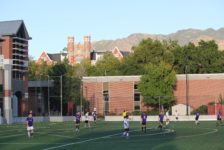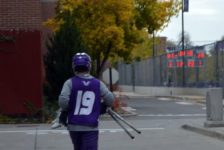
As students head into the backcountry this winter, they should be conscious of their safety. Safety tip: on the way up the hill during the preseason, be sure to take the safest skin tracks–away from avalanche paths. Photos by Blake Bekken
As early-season storms drop enough snow to ski on—but not quite enough to deter the standard pre-season core shots—students are already getting after it in the mountains.
Resorts are expected to open before November is over, with Alta and Brighton opening on Nov. 20 and Solitude the next day.
Students who are heading to the backcountry early this season should always be sure to carry at least the bare necessities: a beacon, shovel, probe and a friend or two.
“There is no such thing as too much avalanche training,” said Jeremy Middlemiss, owner and manager of The Sport Loft, a ski shop in Holladay.
Middlemiss grew up in Salt Lake City, skiing at Alta as a child and making his way into the backcountry in his teen years. While he manages and owns a ski shop during the day, he spends his mornings in the backcountry with the shop crew. His expertise on avalanche awareness and training began at a young age, when he discovered that the backcountry is a fragile environment.
“You have to respect it in order to reap the benefits,” Middlemiss said. “Be sure to take an avalanche [level] one certification course if you have the opportunity. It is important to be able to think on your feet in dire situations.”
Not everyone has the opportunity to take avalanche training courses, but some Westminster professors actually teach these on-snow courses on campus, including adjunct faculty member Kelly Robbins.
Students can take advantage of The Avalanche Awareness class, HPW160 (available Spring semester), which teaches all the basics that the American Avalanche Association covers in their Level I avalanche course. This course covers snow type identification, weather patterns and snowpack stability.
Mena Dardani, junior nursing major who took a class from Robbins, said she believes that it is crucial for skiers and riders to take an “avy” class before hitting the backcountry.
“It is important to take the avy class before heading into the backcountry,” Dardani said. “It provides the chance to learn about what can really happen, how to utilize your tools and also provides an opportunity to realize that your life is not the only one at risk when heading into the backcountry.”
Hannah Barkey, senior and avid backcountry skier, who has already been out over five times this season, echoed Dardani’s thoughts. She said that everyone should receive avalanche training before stepping into the backcountry zone for any kind of winter sport.
“It is imperative that people understand the dangers that snow-covered mountains pose if they want to recreate in areas that are not avalanche controlled,” Barkey said. “Anyone who enjoys skiing, snowboarding, snowmobiling, hiking, snowshoeing, sledding, cross-country skiing in backcountry, lift-accessed backcountry [also known as sidecountry], or even their own backyard needs to be aware of avalanche danger and must know how to appropriately manage said danger.”

Safety tip: Take low-risk lines in the backcountry in the preseason in order to enjoy the deep days this coming winter.
Mena Dardani said the class pushed her to learn how to make decisions as a group and for the benefit of the group as a whole.
“Learning to operate as a group and make decisions based on the safety of the group is the most important thing I learned,” Dardani said.
Avalanche classes provide the tools and education to make different tactical decisions, according to Barkey, avid backcountry skier.
“[Avalanche training] allows you to enjoy your time in the mountains even more while striving to keep yourself and the people around you safe,” Barkey said.
She said she applies avalanche training skills outside of backcountry skiing, as well.
“I personally use trip planning and decision-making skills and knowledge about group dynamics and the human factor that I learned in my avy one course any time that I am enjoying the outdoors,” Barkey said.
When heading into the backcountry with early season conditions through November and December, students should remember to go in a group and check the snow conditions along the way. Early season snowfall can create deadly avalanches, so play it safe even in low-risk zones.









